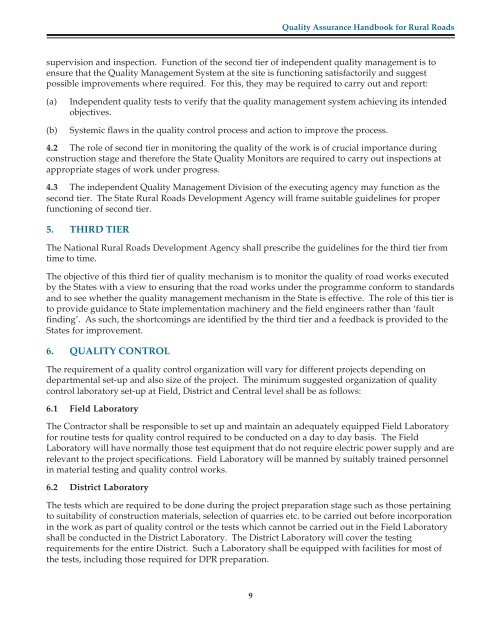Quality Assurance Handbook for Rural Roads Volume-I - pmgsy
Quality Assurance Handbook for Rural Roads Volume-I - pmgsy
Quality Assurance Handbook for Rural Roads Volume-I - pmgsy
You also want an ePaper? Increase the reach of your titles
YUMPU automatically turns print PDFs into web optimized ePapers that Google loves.
9<br />
<strong>Quality</strong> <strong>Assurance</strong> <strong>Handbook</strong> <strong>for</strong> <strong>Rural</strong> <strong>Roads</strong><br />
supervision and inspection. Function of the second tier of independent quality management is to<br />
ensure that the <strong>Quality</strong> Management System at the site is functioning satisfactorily and suggest<br />
possible improvements where required. For this, they may be required to carry out and report:<br />
(a) Independent quality tests to verify that the quality management system achieving its intended<br />
objectives.<br />
(b) Systemic flaws in the quality control process and action to improve the process.<br />
4.2 The role of second tier in monitoring the quality of the work is of crucial importance during<br />
construction stage and there<strong>for</strong>e the State <strong>Quality</strong> Monitors are required to carry out inspections at<br />
appropriate stages of work under progress.<br />
4.3 The independent <strong>Quality</strong> Management Division of the executing agency may function as the<br />
second tier. The State <strong>Rural</strong> <strong>Roads</strong> Development Agency will frame suitable guidelines <strong>for</strong> proper<br />
functioning of second tier.<br />
5. THIRD TIER<br />
The National <strong>Rural</strong> <strong>Roads</strong> Development Agency shall prescribe the guidelines <strong>for</strong> the third tier from<br />
time to time.<br />
The objective of this third tier of quality mechanism is to monitor the quality of road works executed<br />
by the States with a view to ensuring that the road works under the programme con<strong>for</strong>m to standards<br />
and to see whether the quality management mechanism in the State is effective. The role of this tier is<br />
to provide guidance to State implementation machinery and the field engineers rather than ‘fault<br />
finding’. As such, the shortcomings are identified by the third tier and a feedback is provided to the<br />
States <strong>for</strong> improvement.<br />
6. QUALITY CONTROL<br />
The requirement of a quality control organization will vary <strong>for</strong> different projects depending on<br />
departmental set-up and also size of the project. The minimum suggested organization of quality<br />
control laboratory set-up at Field, District and Central level shall be as follows:<br />
6.1 Field Laboratory<br />
The Contractor shall be responsible to set up and maintain an adequately equipped Field Laboratory<br />
<strong>for</strong> routine tests <strong>for</strong> quality control required to be conducted on a day to day basis. The Field<br />
Laboratory will have normally those test equipment that do not require electric power supply and are<br />
relevant to the project specifications. Field Laboratory will be manned by suitably trained personnel<br />
in material testing and quality control works.<br />
6.2 District Laboratory<br />
The tests which are required to be done during the project preparation stage such as those pertaining<br />
to suitability of construction materials, selection of quarries etc. to be carried out be<strong>for</strong>e incorporation<br />
in the work as part of quality control or the tests which cannot be carried out in the Field Laboratory<br />
shall be conducted in the District Laboratory. The District Laboratory will cover the testing<br />
requirements <strong>for</strong> the entire District. Such a Laboratory shall be equipped with facilities <strong>for</strong> most of<br />
the tests, including those required <strong>for</strong> DPR preparation.
















